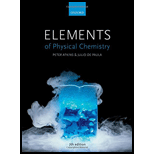
(a)
Interpretation:
For chlorine the temperature at which the equipartition theory becomes valid has to be calculated.
Concept introduction:
Equipartition theorem:
According to the equipartition theorem, the total energy of a molecule is divided equally amongst the various degrees of freedom of the molecules.
(a)
Answer to Problem 2.6PR
The temperature is
Explanation of Solution
According to the equipartition theorem,
Energy contribution by each of the translational degrees of freedom is
Energy contribution by each of the rotational degrees of freedom is
For vibrational degrees of freedom, due to collisions between the molecules each vibrational degrees of freedom possess both kinetic energy and potential energy i.e. each vibration involves two degrees of freedom and hence the energy contribution by each of the vibrational degrees of freedom is given by,
Hence each vibrational degrees of freedom contributes
Now, the equipartition theorem is valid only if
But the separation between the vibrational energy levels is much greater than
It is given in the question that the energy from vibration is given by
According to the question for chlorine the separation between the vibrational energy levels is,
Now the temperature at which equipartition theorem for chlorine is valid that has to be calculated.
Hence,
Chlorine is linear diatomic molecule and hence it will have degrees of freedom
Now at higher temperature only vibrational degrees of freedom of chlorine can show equipartition
Now by expansion,
But higher temperature all the higher terms can be neglected.
Hence the temperature is,
Vibrational energy per mole,
Hence temperature is,
Hence the temperature is
(b)
Interpretation:
For a given exponential
Concept introduction:
Equipartition theorem:
According to the equipartition theorem, the total energy of a molecule is divided equally amongst the various degrees of freedom of the molecules.
(b)
Explanation of Solution
According to the equipartition theorem,
Energy contribution by each of the translational degrees of freedom is
Energy contribution by each of the rotational degrees of freedom is
For vibrational degrees of freedom, due to collisions between the molecules each vibrational degrees of freedom possess both kinetic energy and potential energy i.e. each vibration involves two degrees of freedom and hence the energy contribution by each of the vibrational degrees of freedom is given by,
Hence each vibrational degrees of freedom contributes
Now, the equipartition theorem is valid only if
But the separation between the vibrational energy levels is much greater than
It is given in the question that the energy from vibration is given by
Now the exponential form given is,
Hence expanding
Now using this expansion
Now only at higher temperature vibrational degrees of freedom gives full contribution to the total energy.
Now at higher temperature all the higher terms of the expansion will be very much lesser than one and become negligible
Hence the equation becomes,
Thus at higher temperature the exact expression for vibrational degrees of freedom reduces to the result obtained from equipartition theorem.
Want to see more full solutions like this?
Chapter 2 Solutions
Elements Of Physical Chemistry
 ChemistryChemistryISBN:9781305957404Author:Steven S. Zumdahl, Susan A. Zumdahl, Donald J. DeCostePublisher:Cengage Learning
ChemistryChemistryISBN:9781305957404Author:Steven S. Zumdahl, Susan A. Zumdahl, Donald J. DeCostePublisher:Cengage Learning ChemistryChemistryISBN:9781259911156Author:Raymond Chang Dr., Jason Overby ProfessorPublisher:McGraw-Hill Education
ChemistryChemistryISBN:9781259911156Author:Raymond Chang Dr., Jason Overby ProfessorPublisher:McGraw-Hill Education Principles of Instrumental AnalysisChemistryISBN:9781305577213Author:Douglas A. Skoog, F. James Holler, Stanley R. CrouchPublisher:Cengage Learning
Principles of Instrumental AnalysisChemistryISBN:9781305577213Author:Douglas A. Skoog, F. James Holler, Stanley R. CrouchPublisher:Cengage Learning Organic ChemistryChemistryISBN:9780078021558Author:Janice Gorzynski Smith Dr.Publisher:McGraw-Hill Education
Organic ChemistryChemistryISBN:9780078021558Author:Janice Gorzynski Smith Dr.Publisher:McGraw-Hill Education Chemistry: Principles and ReactionsChemistryISBN:9781305079373Author:William L. Masterton, Cecile N. HurleyPublisher:Cengage Learning
Chemistry: Principles and ReactionsChemistryISBN:9781305079373Author:William L. Masterton, Cecile N. HurleyPublisher:Cengage Learning Elementary Principles of Chemical Processes, Bind...ChemistryISBN:9781118431221Author:Richard M. Felder, Ronald W. Rousseau, Lisa G. BullardPublisher:WILEY
Elementary Principles of Chemical Processes, Bind...ChemistryISBN:9781118431221Author:Richard M. Felder, Ronald W. Rousseau, Lisa G. BullardPublisher:WILEY





